Java Frameworks
 In the world of Java, living without a known operating system is supposed to be liberating. What is more subtle in this world of freedom is life without a known framework. My earlier Java revelation included the discovery of the platform—now I am seeing the framework. It looks like the platform defines interfaces and types for objects and the framework is the space where the objects romp—from database to platform object or from file system to API object, etc. Here are some bullets flying around:
In the world of Java, living without a known operating system is supposed to be liberating. What is more subtle in this world of freedom is life without a known framework. My earlier Java revelation included the discovery of the platform—now I am seeing the framework. It looks like the platform defines interfaces and types for objects and the framework is the space where the objects romp—from database to platform object or from file system to API object, etc. Here are some bullets flying around:
- Spring. In the rasx() context, Spring is the result of an internal revolt against almost everything I dislike about using Java in “Service Oriented Architecture” solutions. Michael Juntao Yuan in “POJO Application Frameworks: Spring Vs. EJB 3.0,” writes, “…J2EE 1.4 is widely considered poorly designed and over-complicated.” So Spring simplifies and introduces me to cute stuff like dependency injection, model-view-controller and a biggie, ORM. Check out “Introduction to the Spring Framework” by Rod Johnson.
- Hibernate is a popular ORM framework. This takes care of the romp from a database that knows nothing about Java to the world of Java objects. In the “O/R mapping integration” section of “Introduction to the Spring Framework,” Rod explains why one would need Spring and Hibernate.
- Castor is “the shortest path between Java objects, XML documents and relational tables.” Because Hibernate does not instantiate objects from XML files, Castor is used with Hibernate.In my familiar world of Microsoft, there is only one framework, the .NET Framework. Java people will cast their Lord-of-the-Rings aspersions but what really matters is the relatively weak transaction support in the .NET Framework. There are great improvements in .NET 2.0 which explains Juval Lowry’s excitement in “Introducing System.Transactions in the .NET Framework 2.0.” However, Don Box and his posse are not working so hard on Indigo for their health…
